3 Approaches to Conversion Rate Optimization (CRO)
*This post was originally published on April 17, 2018 and has been updated to reflect the changing landscape of CRO and digital marketing.
Have you ever been on a website that bombards you with five different pop up messages and offers in your first 20 seconds on the site?
And you turn around, back to the land of Google search, wondering why you ever clicked on that website in the first place?

Table of Contents:
- What is Conversion Rate Optimization?
- Conversion rate benchmarks by industry
- How to choose the right CRO Methodology
- Which approach is best?
What is Conversion Rate Optimization (CRO)?
CRO, or conversion rate optimization, is the process of systematically turning website visitors into customers.
The website that we described above left out the ‘systematically’ component of the definition. Effective CRO is not just blasting your users with opportunities to convert.
![]()
If you’re looking for ways to grow – and you have limited time, budget, and opportunities (hint: this is all marketing programs, everywhere), the usual suspects look something like this:
- PPC: use paid ads to grow traffic and leads
- SEO: write more content based on long-tail keywords and relevant phrases to attract more traffic
- Social Media: post more to get more followers, boost those posts for more visibility, then retarget your followers with ads to turn a select few into leads
None of these are bad strategies. In fact, these all may be excellent strategies for your business.
But if you’ve ever held a glass under the sink for too long, you understand the problem of growing your traffic without a plan to convert.
Enter stage right: Conversion Rate Optimization
Given limited resources, conversion rate optimization can be a more efficient way to grow than focusing on increasing website traffic.

Why spend time and money getting more people to your store if the people already in there aren’t buying anything?
To use another water metaphor – it’s like pouring water into a leaky bucket. You keep pouring. It keeps dripping out. The opportunities are watering the dirt instead of your nice flowerbed.
If you focus on improving the conversion rate of the traffic you already have, it can drive more revenue and keep your boss extra happy.
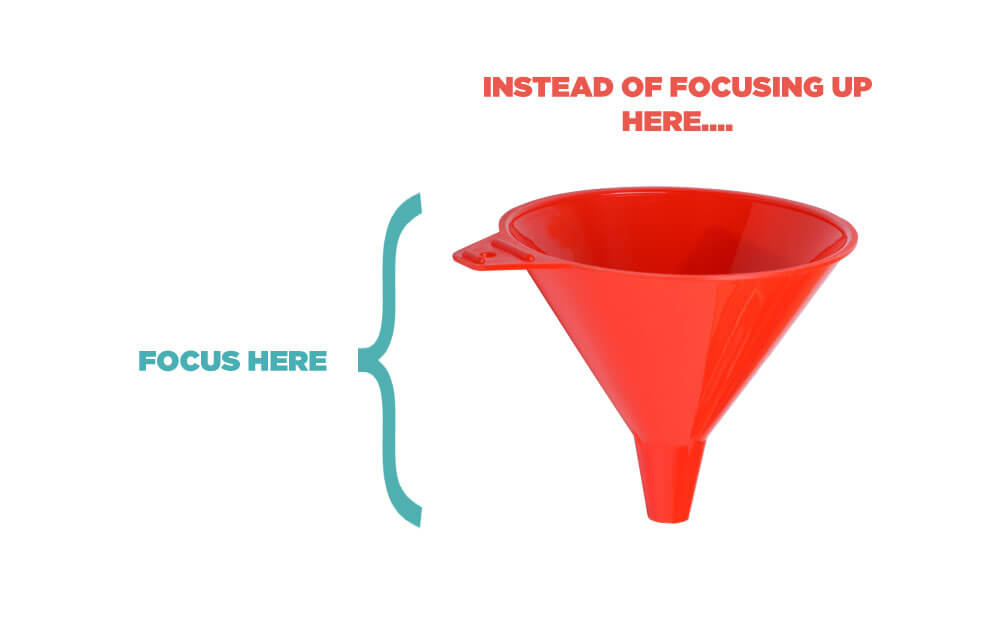
What is a conversion?
It’s worth pausing for a moment to define our terms. You can slice and dice a conversion in a few different ways, depending on what goals you’re trying to accomplish.
 “Conversion” can be a slippery term, because the definition is a user completing a desired action. So, step one is to define what a conversion means for your specific campaign, website, business, boss, etc.
“Conversion” can be a slippery term, because the definition is a user completing a desired action. So, step one is to define what a conversion means for your specific campaign, website, business, boss, etc.
For an eCommerce business, a conversion might be the sale of an SKU (stock-keeping unit). If your store is called Widgets, Inc., and a shopper visits your site and buys a widget – boom, that’s a conversion.
If you’re a B2B services business (like Magneti), a conversion might be a bottom-of-the-funnel form fill: a la the fabled “Contact Us” form.
However, a “conversion” doesn’t just have to apply to the bottom-of-the-funnel (or purchase intent).
It can also apply to actions at the top-of-the-funnel (i.e. subscribing to your blog) or the middle-of-the-funnel (i.e. downloading a resource or a return visit to your site).
If you’re looking at your website and want to calculate a holistic conversion rate, typically you’re looking at one of two methods:
-
- Analyze all form fills – meaning a web visitor (aka a stranger) becomes a web lead (aka gives you a way to stay in touch with them)
- Just analyze bottom-of-the-funnel form fills – meaning a prospect enters your sales process by raising their hand and asking to get in touch with you. Or, if you sell products, they buy one.
So then, what is a conversion rate?
Okay, now you’ve got your conversions defined (the ‘C’ in CRO). The conversion rate (The ‘CR’ in CRO) is simple: it’s just the rate at which visitors to your site convert.
How many website visitors take the desired action you want them to take, out of all the potential visitors who could have taken that action?
Or – if you’re tracking an action on a particular landing page, how many visitors to that page convert by fill out the form, signing up for the webinar, subscribing to your list, requesting more info, etc.
By nature, a conversion rate is historical. You’re looking at past behavior to analyze performance.
Playing with time frames and looking for variations can be a helpful input when you’re assessing whether you’re happy with your conversion rate – or whether it needs some tender loving care (optimization).
How do I calculate a conversion rate?
Easy. Just a little basic math:
- Divide the number of conversions by the number of visitors
- Multiply that number by 100 to get a percentage
- That percentage is your conversion rate

What conversion rates should I be seeing?
Finding relative benchmarks can be an immensely helpful comparison tool. You can find conversion rate benchmarks broken down by industry:
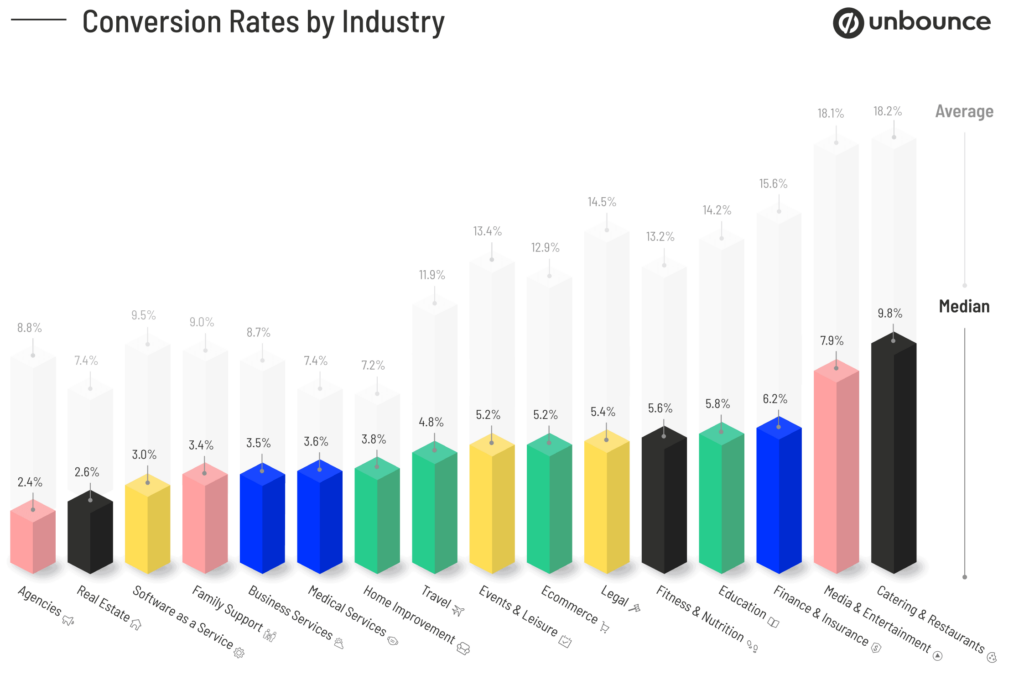
Source: Unbounce’s 2021 Conversion Benchmark Report
And even by channel:
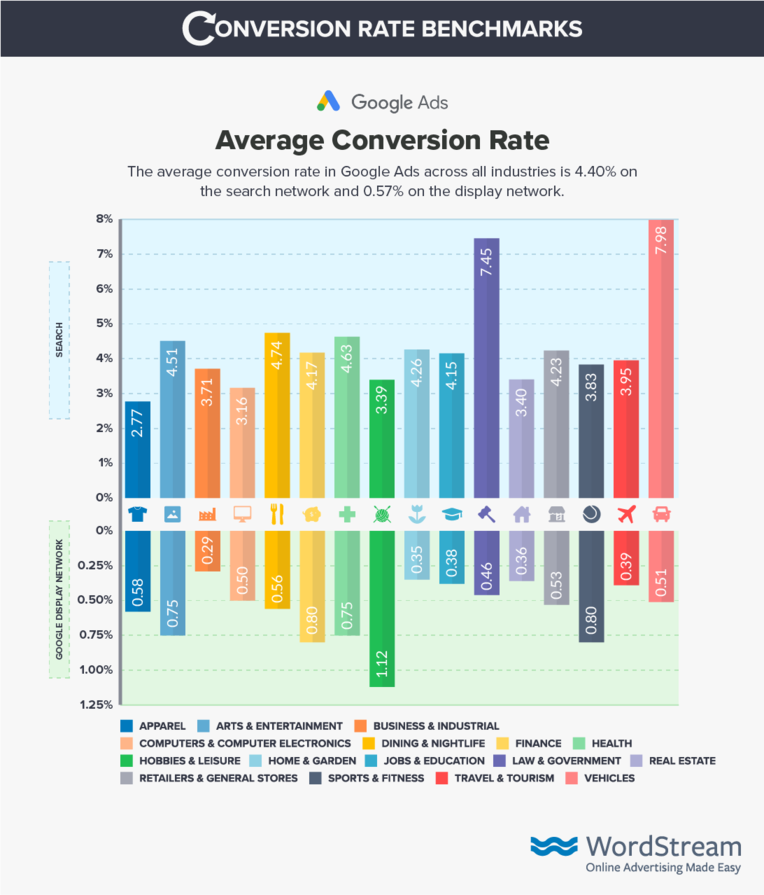
Source: Wordstream’s Conversion Rate Benchmarks
Here are a few, reliable sources where you can find frequently updated and helpful conversion rate data:
- Unbounce’s Annual Conversion Benchmark Report
- Wordstream’s Conversion Rate Benchmarks, which includes:
- Average Google Ads conversion rates by industry
- Average Google Ads cost per conversion by industry
- Average Facebook Ads conversion rate by industry
- Average Facebook Ads cost per conversion by industry
- Google Ads mobile conversion rate benchmarks by industry
- Google Ads mobile cost per conversion benchmarks by industry
- Google Shopping (ecommerce) conversion rates by industry
- Google Shopping (ecommerce) costs per conversion by industry
- Bing Ads conversion rate benchmarks by industry
- Bing Ads cost per conversion benchmarks by industry
- Ruler Analytics’ Average Conversion Rate by Industry and Marketing Source
- invesp’s Average Website Conversion Rates by Industry
- SmartInsights’ aggregation of eCommerce data from multiple sources
If you’re staring at these benchmarks and thinking, oh no, we’re not even close, or, if you’re looking to grow on a trajectory of your own to meet ambitious revenue goals or grow your business, the next step is to decide how to approach conversion rate optimization (the “CRO” in CRO).
Conversion rate optimization is the systematic process of improving how many people take that desired action out of a given pool of visitors.
More conversions = more leads. More leads = more sales opportunities. More sales opportunities = more growth.
How to Choose the Right CRO Methodology
There are lots of different ways to approach CRO, and understanding your options can help ensure you’re taking the right approach for your goals.
Choosing a CRO methodology means choosing a framework to help you evaluate areas of opportunity and make improvements.
Here are three approaches to keep in mind when looking to optimize your conversion rate. Read through each one, weigh the pros and cons, then pick the approach that’s best for you.

Approach #1: Best Practices
Best practices are generally technical and data-driven operating procedures centered around psychological motivators.
For example, it is generally known that mobile buttons should be no less than 44 pixels on any side, and red call-to-action buttons generally convert better than any other color.
Best practices compile broad industry data to make assumptions that can be applied to any website challenge.
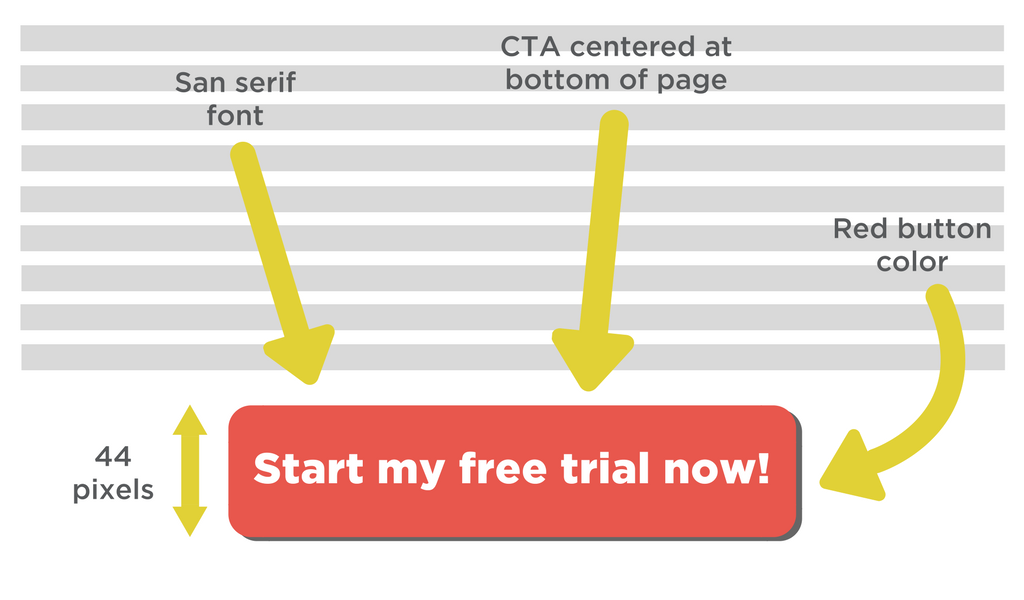
However, since best practices are based on proven successes, they can be slow to spread. This means that a best practice can become dated before it’s replaced with a more successful industry practice.
Every audience has its own unique needs, wants and behavioral patterns. Just because you’re an online t-shirt shop, it doesn’t mean your customers will follow the same patterns as all other online t-shirt shops.
A college apparel store has a vastly different customer base than a company that makes little league uniforms.
While there may be some behavioral overlap, trying to apply the same industry best practice to both is likely to yield different results. Doing research to determine the buyer’s journey of your particular audience is key!
It’s important to use best practices as suggestions (and not as blanket rules) in order to optimize for each specific business and goal.
Your team can develop best practices for each business or client you work with over time using the next two approaches as helpful frameworks.
Pros of using best practices
- Best practices become best practices by driving success at scale from a wide variety of tests
- They’re typically data-backed with lots of conversations and studies to point to.
- …Which makes them relatively safe creative choices that earn easy buy-in from even the most skeptical folks in the room
Cons of using best practices
- Since they’re widely known and adopted, they can become out-of-date quickly
- They often push features to look more similar to their competitors rather than differentiated and unique – and, therefore, memorable
- They don’t take into account the unique nuances of individual brands, websites, or audiences
Where to find best practices
- Our recommended way to source best practices is to look for similarities between a few major players in your industry. Do they all present the same style and color of ‘cart’ checkout icon and process? Do their website structures and hierarchies look the same? Some quick benchmarking can help you find areas to build on – and ways to intentionally set yourself apart.
- Marketers are consistently documenting and sharing ways to do things better to become known as a memorable source for helpful insights.
- The HubSpot blog has become known as one the most comprehensive sources of best practices through their dedication to consistent content production to help marketers over the last two decades.
- The Growthhackers blog provides a variety of best practices and ways to improve individual channels.
- This list of top digital marketing newsletters can help you stay up-to-date with best practices from the comfort of your own inbox.
Approach #2: Inbound Methodology
This approach focuses on content marketing and doesn’t sweat the technical variables. Inbound methodology taps into the power of creating intentional content, building good, thoughtful personas, and following the buyer’s journey:
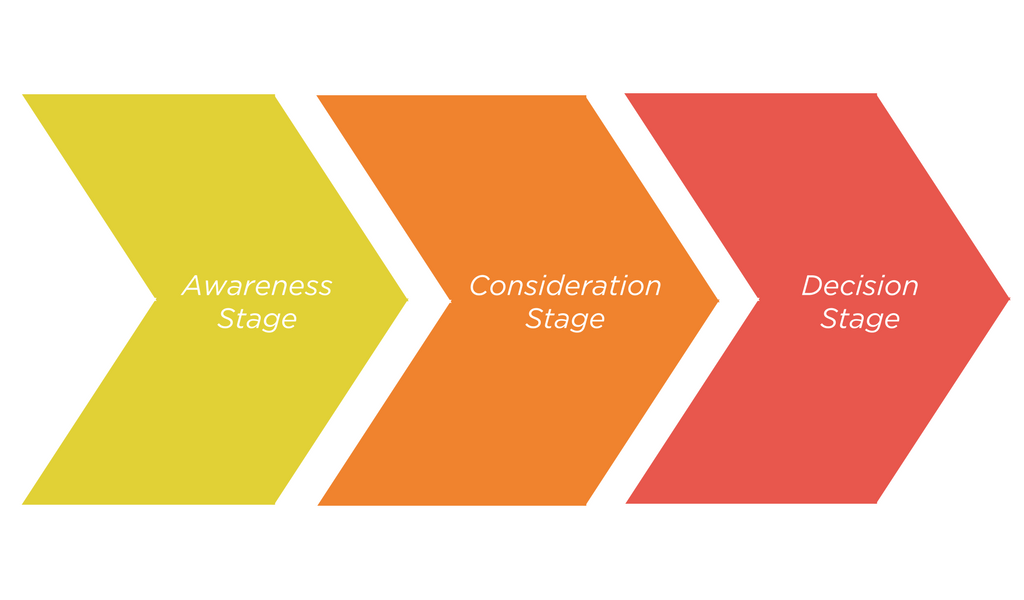
Why Inbound Methodology for CRO?
Inbound marketers believe that following this methodology and analyzing the results along the way will gradually increase conversion rates over time.
By showing personas what they want to see when they want to see it, inbound methodology expects to see conversion rates naturally increase.
These phases begin with educating a future customer on a problem they may not even be able to name yet (and are only able to describe the symptoms), guiding them through the landscape of options, and finally ending with a purchase decision.
The Awareness Stage
The Awareness Stage is the first step of the buyer’s journey and focuses on attracting strangers.
Not just any strangers though – ones who are experiencing a problem and are looking define and label it. It’s often summarized as becoming “pain / problem aware.”
For example, the awareness phase for someone with the common cold might be a search around ‘I’m sneezing, my eyes are running, and I’m coughing an awful lot.’
What does CRO look like in the Awareness Stage?
For CRO, this means optimizing your top-of-the-funnel content with the well-worded CTAs that can easily guide personas to the information they’re looking for.
And by laying out your content in easy, skimmable fashion so they can find the areas they want to dive into.
Tools like a table of contents or similar recommended resources can be helpful here (think FAQs and ‘People Also Ask’ style content).
Focus on first-impression areas like page titles and meta descriptions that can entice searchers to choose your helpful content, rather than a competitor’s.
The Consideration Stage
The Consideration Stage is the second step of the buyer’s journey and focuses on finding solutions for the problem that’s now been defined.
It’s often summarized as becoming “solution aware.”
For example, the consideration phase for someone with the common cold might be a search around ‘the best ways to treat the common cold.’
They might find a few different solutions: see a doctor, take medicine, drink hot tea and chicken soup, or get lots of sleep, drink lots of water, and wait it out.
They might even combine some of those options.
What does CRO look like in the Consideration Stage?
The consideration stage is largely about context and showcasing a landscape of solutions.
CRO activities here could include:
- Focusing on improving downloadable resources that offer different solutions (and pros / cons for one road over the other)
- Building out additional resources or blog posts to help someone discover and explore the full landscape of solutions on your website
- Or simply offering tools like chat or FAQs to help them find answers to the most likely questions they’re wrestling with when choosing a solution.
The Decision Stage
The Decision Stage is the final step of the buyer’s journey and focuses on choosing a provider after deciding on the best solution for a problem.
It’s often summarized as becoming “provider aware.”
For example, the decision phase for someone with the common cold might look like this: they’ve decided they want medicine are now exploring of the pros and cons of different providers.
‘Do I want drowsy or non-drowsy. What are the active ingredients in Dayquil vs. this generic store brand that’s half the cost?’
What does CRO look like in the Decision Stage?
CRO in the decision stage often involves examples and proof metrics.
Adding positive reviews and testimonials, providing different types of relevant case studies that are easy to navigate, and showcasing awards and even personalities of who a person might be working with (in the case of B2B) can be the difference between them converting on your site or choosing a competitor instead.
To fully commit to inbound methodology, you have to prioritize being helpful over being profitable – and many businesses have discovered that prioritization as the best road to being more profitable.
Pros of using inbound methodology
- Inbound is built on attraction – rather than interruption – so, each attempt moves you towards delighting your audience instead of frustrating them.
- Inbound is an exercise of empathy, discovering what problems your audience faces at each phase of the buyer’s journey and can therefore help inform a comprehensive marketing strategy that is audience-focused and genuinely helpful to them.
- Inbound places CRO in the context of a bigger vision: helping people find the information they’re already looking for. Each CRO decision can be mapped to a larger marketing strategy rather than exist in a vacuum.
Cons of using inbound methodology
- Attraction can be a slow journey, with immense competition
- Results don’t often come quickly, and CRO efforts are reliant upon volumes of high-quality content creation
- Inbound isn’t as focused on CRO as a unique set of activities, which can lead you to focus more time on content creation vs. refinement and optimization
Where to learn more about inbound
- Inbound was pioneered by HubSpot and grew in popularity as a response to interruption-based marketing approaches. HubSpot’s training resources provide an excellent way to get up to speed on all-things-inbound.
- For a 201 run-through, find out how to use inbound marketing to generate buyer personas and grow your digital marketing presence here.
Approach #3: Data Testing
Testing your site is a highly data-centric approach to CRO, but a more tailored, specific and nuanced one. It allows for split testing (also known as A/B testing) to see what performs best, and therefore allows marketers to learn from each unique website visitor.
Each company in a given space is uniquely different and can attract different types of audiences – and data testing can scratch that itch better than best practices.
How does A/B Testing work?
In the example below, a web page is split to test the conversion rates of two different buttons.
The buttons go to the same place, but vary in appearance and copy. When the split test ends, marketers implement whichever button had higher conversion rates.
Then they test it again, days or months or years later, once they’ve cycled through the full landscape of user elements available for testing, constantly improving the web experience.
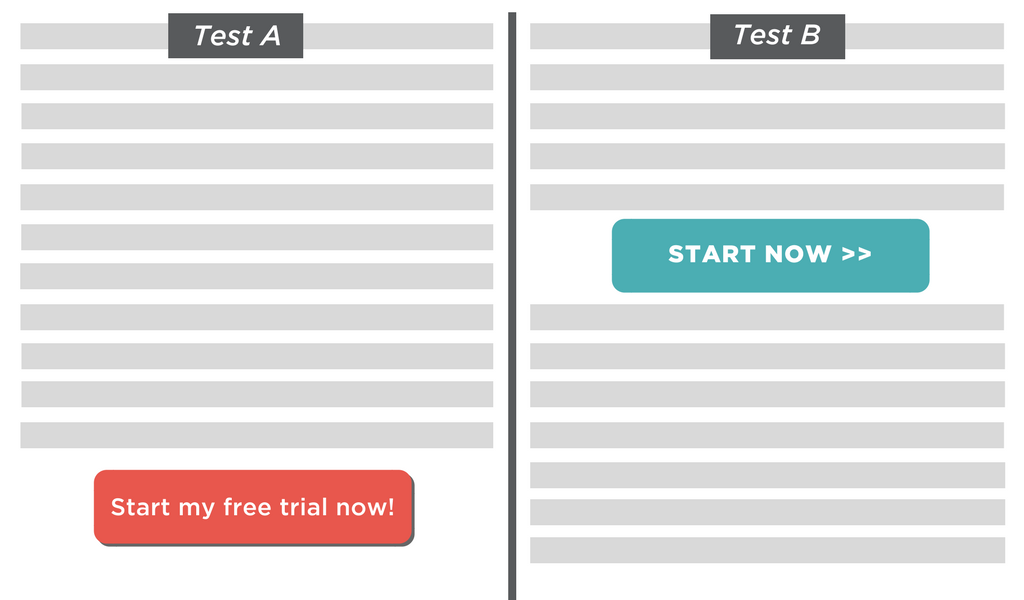
In order to do statistically significant split testing, it is important that there is enough data. Basing major decisions on minimal data is not a best practice.
If you have the data to enable split testing, use tools like Optimizely or Visual Web Optimizer.
If you don’t, relying on best practices is a good go-to strategy as you the build the traffic needed to get real-time feedback on user elements.
Data testing incorporates inbound methodology, but asks: “What can we refine for this client that is unique to them and their buyer’s journey? What can we test to optimize conversions for this particular client?”
Pros of using data testing
- Data testing, audits, and consistent analysis provide data that is directly tied to your audience and your business
- You can often adapt things in real time, like shifting over to the CTA that’s performing the best
- Data testing can show you a level of depth and degree of granular insights that frameworks like inbound and best practices rarely dare to comment on
Cons of using data testing
- You’re only testing what you produce, which can provide tunnel vision; a limited perspective based on a limited amount of variables that best practices and inbound can help address
- Testing is time-intensive. Instead of designing one version of a CTA, now you’re doubling that workload – plus adding time on the back-end for analysis and consolidation to the best performer.
- It’s almost impossible to test objectively. All marketers can do is rely on correlation to create more tests and ideally ratchet up the level of results each time.
- Consider an email send: there are factors like what other emails show up in a recipient’s inbox that day, whether or not they’re in a tense meeting when they get it, how much sleep a they got the night before, whether they had an early or late lunch, etc. – all factors that makes clear causation unrealistic.
Where to learn more about data testing
- There are lots of tools that can help you analyze data over time and test different versions of creative:
- Google Analytics, especially tools like events and UTM tracking codes
- Optimizely
- Visual Web Optimizer
- Crazy Egg
- HubSpot and most other major email providers
So, which approach is best for increasing conversion rates?
We generally abide by strong data testing methodology to achieve data-driven inbound marketing.
Best practices are great as a starting point, but defining your own approach and communicating it well through constant tinkering will yield the best results.
Plus, it gives you a chance to stand out from the competition.
Balance strong personas with the power of testing to reduce the risk of missed conversion opportunities.
Want help thinking about CRO and driving better results? We love talking about this stuff, and we love driving absurd results with it.


